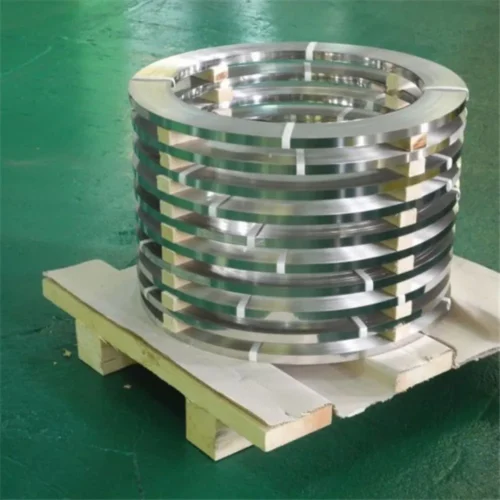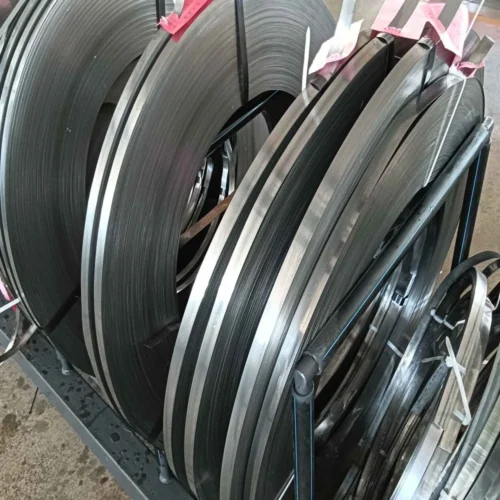301, 1.4310 spring stainless steel strip
301, 1.4310 is an austenitic stainless, general purpose steel with good spring properties that in most cases fulfill demands regarding corrosion resistance, mechanical strength, fatigue and relaxation properties.
Service temperature: up to 250°C (480°F)
Standards
- ASTM: (301)
- EN Number: 1.4310
- EN Name: X 10 CrNi 18-8
- SS: 2331
Chemical composition (nominal)
Chemical composition (nominal) %
| C | Si | Mn | P | S | Cr | Ni |
| 0.10 | 1.2 | 1.3 | ≤0.030 | ≤0.010 | 16.5 | 7 |
Applications
301, 1.4310 is suitable for springs and other high strength components in the mechanical, electronics and computer industries. It is a very good spring material that in most cases fulfils demands regarding corrosion resistance, mechanical strength, fatigue and relaxation properties.
Corrosion resistance
It is very important to avoid corrosion in spring applications so as not to impair spring properties. 301, 1.4310 is an austenitic stainless steel and has sufficient corrosion resistance in most spring applications. The corrosion resistance is almost the same as ASTM 304 and, compared to other low alloyed spring steels, 301, 1.4310 has superior performance. However, all austenitic steels of this type are susceptible to stress corrosion cracking (SCC) when in contact with chloride solutions at elevated temperatures.
Bending
The values given below have been obtained by bending according to Swedish standard SS 11 26 26 method 3 (in a 90° V-block with a 25 mm die opening, a sample of 35 mm width, turned so that the burrs of the blanked edges face into the bend). They can be used as guidance for the smallest recommended bending radius.
| Nominal tensile strength, Rm | Thickness (t) | Min. bending radius as function of thickness* | |
| MPa | mm | ⊥ | // |
| 1300 | 0.25 | 0.5 t | 1 t |
| 1300 | 0.50 | 0.5 t | 2.5 t |
| 1300 | 0.75 | 1 t | 3 t |
| 1300 | 1.0 | 1 t | 3.5 t |
| 1500 | 0.25 | 1 t | 3.5 t |
| 1500 | 0.50 | 1 t | 5 t |
| 1500 | 0.75 | 1.5 t | 5.5 t |
| 1500 | 1.0 | 2 t | 6 t |
| 1700 | 0.25 | 1.5 t | 6.5 t |
| 1700 | 0.50 | 2 t | 9 t |
| 1700 | 0.75 | 2.5 t | 9.5 t |
| 1700 | 1.0 | 3 t | 9.5 t |
| 1900 | 0.25 | 2 t | 10 t |
| 1900 | 0.50 | 3.5 t | 11 t |
| 1900 | 0.75 | 5 t | 12 t |
∗)⊥ Bend transverse to the rolling direction
// Bend parallel to the rolling direction
Forms of supply
301, 1.4310 is supplied, as standard, in the cold rolled condition. Strip steel can be supplied in coils, bundles, on plastic spools or in lengths. The edges can be either slit, deburred or smoothly rounded. Contact us for more information.
Dimensions
The following range of thicknesses and widths can be supplied as standard. Please contact Alleima if other dimensions are required.
| Thickness, mm | Width, mm | Thickness, in. | Width, in. |
| 0.015 – 3.00* | 2 – 345 | 0.0006 – 0.118 | .079 – 13.6 |
* Depending on requested tensile strength.
Tolerances
The thickness and width tolerances are +/- tolerances to the nominal size. The normal tolerance classes for most of our strip products are T2 and B1. Tighter tolerances as well as other tolerance limits can be offered upon request.
Stock standard
The following combinations of tensile strength and thickness are available from stock. Other combinations can be supplied on request.
| Condition* | Tensile strength, Rm | Thickness | |
| MPa | ksi | mm | |
| C | 1300 | 189 | 0.20/0.30/0.40/0.50/0.60/0.80/0.90/1.00 |
| C | 1500 | 218 | 0.10/0.15/0.20/0.25/0.30/0.40/0.50/0.60/0.70/ 0.80/1.00/1.5/2.0 |
| C | 1700 | 247 | 0.10/0.15/0.20/0.30/0.40/0.50/0.60/0.90/1.00 |
* C = Cold rolled
Heat treatment
The strength of cold rolled 301, 1.4310 can be increased by a tempering operation at 350°C (662°F) for 3 hours. An increase in tensile strength up to approx. 150 MPa (22 ksi) can be expected, depending on the initial cold rolled tensile strength. Further information on the nominal tempering effect can be seen under the “Mechanical properties” section. This heat treatment is also beneficial for relaxation and fatigue resistance.
Tempering is normally carried out by the customer after forming. To avoid discoloration, parts should be carefully cleaned before heat treatment. Tempering in open air furnaces gives a harmless brownish oxide on the surface.
Mechanical properties
Static strength
Nominal values at 20°C (68°F)
| Condition1) | Tensile strength, Rm | Proof strength, Rp0,2a) |
Elongation, A11,3 |
||
| MPa | ksi | MPa | ksi | % | |
| A | 850 | 116 | 300 | 44 | 50 |
| C | 1300 | 189 | 1150 | 167 | 15 |
| CT | 1350 | 196 | – | – | – |
| C | 1500 | 218 | 1375 | 199 | 8 |
| CT | 1580 | 229 | – | – | – |
| C | 1700 | 247 | 1625 | 236 | 1.5 |
| CT | 1800 | 261 | – | – | – |
| C | 1900 | 276 | 1825 | 265 | 1 |
| CT | 2000 | 290 | – | – | – |
1) A = Annealed, C = Cold rolled, CT = Cold rolled and tempered, 350°C (662°F)/3 h. See further under section ‘Heat treatment’.
- a) R2 corresponds to 0.2% offset yield strength.
1 MPa = 1 N/mm2
Fatigue strength
Nominal values at 20°C (68°F) in a normal dry atmosphere. The fatigue limit is defined as the stress at which 50% of the specimens withstand a minimum of 2 million load cycles.
Reversed bending stress
Average stress = 0
Bending transversal to rolling direction.
Comparison made for different thicknesses and tensile strength levels.
| Tensile strength, Rm | Fatigue strength | Tensile strength, Rm | Fatigue strength | ||
| Thickness, mm | Thickness, in. | ||||
| 0.50 | 0.75 | 0.020 | 0.030 | ||
| MPa | MPa | MPa | ksi | ksi | ksi |
| 1500 | ± 555 | ± 525 | 218 | ± 80.5 | ± 76.2 |
| 1700 | ± 560 | ± 545 | 247 | ± 81.3 | ± 79.1 |
| 1900 | ± 570 | ± 560 | 276 | ± 82.7 | ± 81.3 |
| 2000 | ± 600 | ± 580 | 290 | ± 87.1 | ± 84.2 |
Fluctuating tensile stress
Minimum stress = 0
Specimens parallel to rolling direction.
Comparison made for different thicknesses and tensile strength levels.
| Tensile strength, Rm | Fatigue strength | Tensile strength, Rm | Fatigue strength | ||
| Thickness, mm | Thickness, in. | ||||
| 0.25 | 0.50 | 0.010 | 0.020 | ||
| MPa | MPa | MPa | ksi | ksi | ksi |
| 1500 | 420 ± 420 | 405 ± 405 | 218 | 60.9 ± 60.9 | 58.8 ± 58.8 |
| 1700 | 460 ± 460 | 425 ± 425 | 247 | 66.8 ± 66.8 | 61.7 ± 61.7 |
| 1900 | 475 ± 475 | 445 ± 445 | 276 | 68.9 ± 68.9 | 64.6 ± 64.6 |
| 2000 | 480 ± 480 | 460 ± 460 | 290 | 69.7 ± 69.7 | 66.8 ± 66.8 |
Physical properties
The physical properties of a steel relate to a number of factors, including alloying elements, heat treatment and manufacturing route, but the following data can generally be used for rough calculations. These values refer to cold rolled material, at a temperature of 20oC (68oF) unless otherwise stated.
Density 7.9 g/cm3 (0.29 lb/in)
Resistivity 0.8 μΩm (31.5 μΩin.)
Modulus of elasticity
‘as delivered’: approx 185 000 MPa (26 825 ksi)
tempered: approx 190 000 MPa (27 550 ksi)
Shear modulus
‘as delivered’: approx 70 000 MPa (10 150 ksi)
Specific heat capacity 500 J/kg °C (in the temperature range 50-100°C (120- 210 oF)
Thermal expansion mean values in temperature ranges (x10-6)
| Temperature, °C | per °C | Temperature, °F | per °F |
| 20 – 100 °C | 15.5 | 68 – 200 | 8.5 |
| 20 – 200 °C | 16 | 68 – 400 | 9 |
| 20 – 300 °C | 16.5 | 68 – 550 | 9 |
Thermal conductivity
| Temperature, °C | W/m °C | Temperature, °F | Btu/ft h °F |
| 20 | 15 | 68 | 8.5 |
| 100 | 16 | 200 | 9 |
| 300 | 19 | 600 | 11 |
Welding
301, 1.4310, like most austenitic stainless steels, has a good weldability. Welding, however, introduces excess heat into the material closest to the weld that breaks down the structure formed by cold working. As a consequence, this will decrease the mechanical properties of the welded area. The lowest practical heat input, <1.0 kJ/mm, and interpass temperature for multipass welding, <100°C (210 oF), is recommended.
In most cases, the TIG (GTAW) method is preferable. It can be used either autogenously (without filler metal) or with filler metal. In both cases, pure argon (99.99%) should be used as the shielding gas.
When filler metal is used, the recommenation is to do it according to standard ISO 14343-A: 19 9 L; AWS A5.9/ASME SFA-5.9: ER308L; W.Nr.: 1.4316 and ISO 14343: 19 9 L Si; AWS A5.9/ASME SFA-5.9: ER308LSi; W.Nr.: 1.4316.
Due to the high carbon content of 301, 1.4310, there is also a risk of carbide precipitation at the grain boundaries of the material in the heat affected zone (HAZ), which may decrease the corrosion resistance of the material in certain environments.











